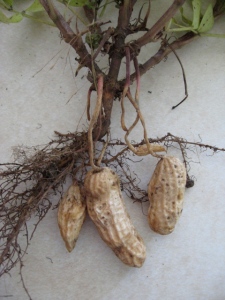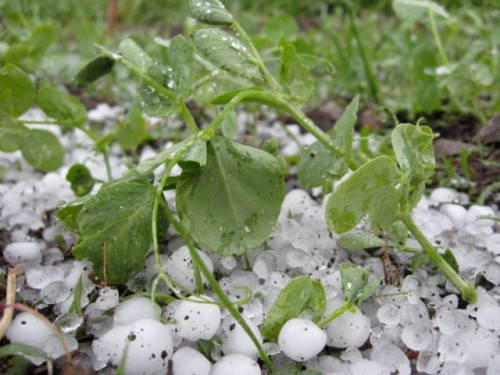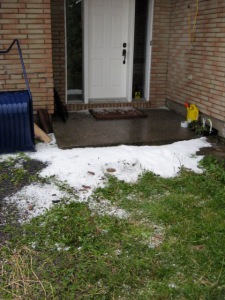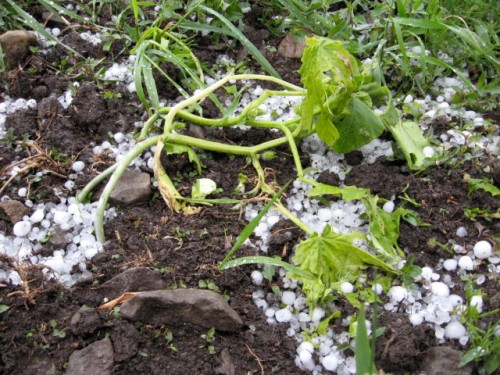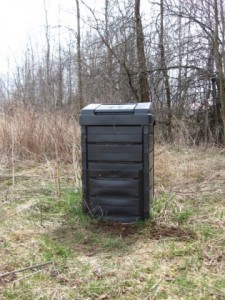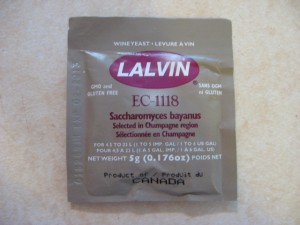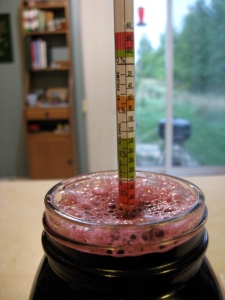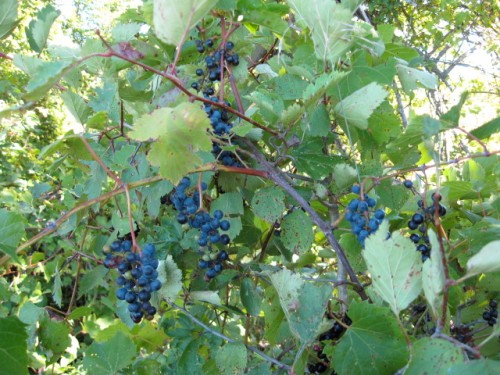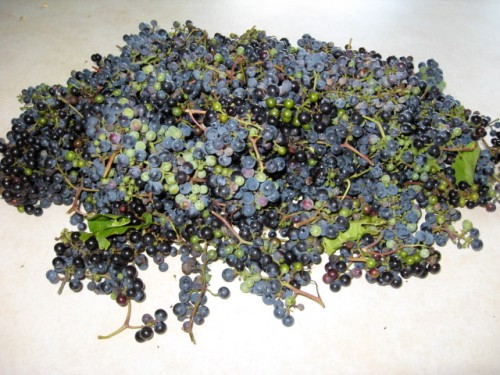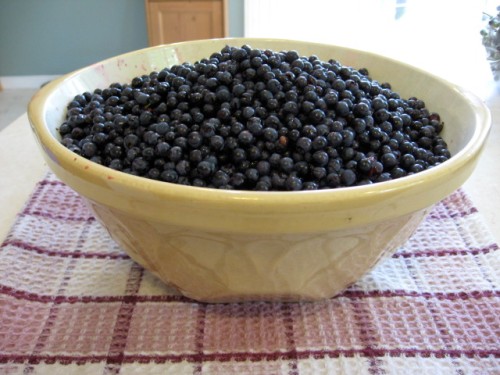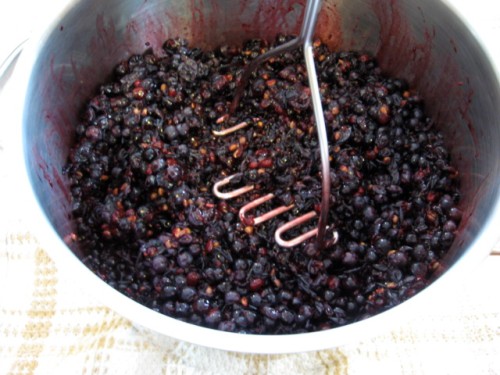My friend Amanda writes a food blog called The Mindful Table. Recently she linked to an article written by someone who raises their own backyard chickens, and who tried to make coq-au-vin with one of her old laying hens. I say “tried” because she gave up after simmering the chicken for 4 hours, deciding that the meat would “never be tender” and she substituted a store-bought chicken. I was disappointed to read this, because it implied that older chickens are inedible, even in a dish specifically designed to use them, such as coq-au-vin. I have been planning to make coq-au-vin for a while, and we had plans for a dinner guest this past Saturday evening, so the article inspired me to make my own attempt at coq-au-vin.
I used Hugh Fearnley-Whittingstall’s recipe from The River Cottage Meat Book. In the description of the dish he says, “This is a great dish but there is no doubt it has fallen out of favour. The reason is simple: the central ingredient – a farmyard cockrel… – is almost impossible to lay your hands on.”
As we have our own chickens, and thus, “spare roosters,” there was no problem in obtaining the central ingredient:
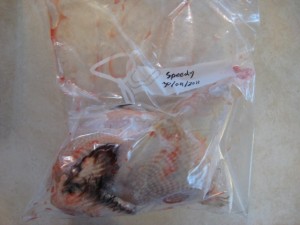
Those of you who have been reading this blog for a while may well remember the Saga of Speedy – how he got his name by being too fast to catch for slaughter during our first year of chicken-keeping, and then how he was too rough on the girls, and Chief (our alpha rooster) started chasing him off. How he spent a summer living on our (very accommodating, elderly Estonian) neighbour’s front lawn, and how once we had a replacement rooster (one of The Twins – who have their own story – livestock keeping is full of anecdotes) we dispatched Speedy. He’s been sitting well-wrapped in our freezer ever since, and this weekend he was going to make his (hopefully) triumphant final exit.
The actual difficult-to-obtain ingredient was “250g salt pork, pancetta, or bacon, in chunky pieces.” I.e. un-sliced. Unsliced bacon (or salt pork) can be bought in your average North American supermarket. But we only eat local / organic / naturally raised meat. And I wasn’t going to let the results of the commercial pork-farming industry anywhere near one of my own organic chickens!
While working at the Champlain Commercial Fair this past March, I met the folks who run Bearbrook Game Farm and asked if they might have any unsliced bacon. They kindly found me a piece of wild boar bacon – so I had the other key ingredient for the recipe in my freezer. 250 grams ended up being half of this piece. Expensive, yes – but it was the only expensive ingredient in a fancy dinner for 4 people (after all, the chicken was “free,” right?)

Having taken both Speedy and the bacon out of the freezer to defrost in the fridge on Friday morning, Saturday morning I was ready to start preparing the dish. The only major departure I made from Hugh’s recipe was that instead of cooking covered “over a very low heat, or in a very low oven (120°C Gas Mark 1/2) for about 2 – 2 1/2 hours, until the meat is completely tender,” I simmered it on “low” in the slow-cooker for 5 hours. I have learned through experience that I enjoy the experience of having dinner guests a lot more if the meal I’m going to serve is done and bubbling gently in the slow-cooker when my guests arrive!
Ingredients:

Tomatoes, skinned, de-seeded, and finely chopped. I was, unfortunately, using conventionally grown vegetables, due to the time of year. Next time I make coq-au-vin (and there will definitely be a next time), I’ll do it in the fall when I can get local organic veggies. I noticed that the skins on the tomatoes were much thicker then the ones I grow (or the ones I buy at my local farmer’s market) for processing into home-canned tomato sauce – to better withstand transport, of course…
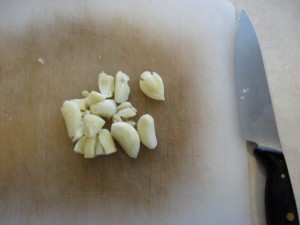
Garlic. The recipe calls for “4 garlic cloves, bruised” I used “a bunch” of garlic – we like our garlic – and decided that “bruised” meant “sort-of-crushed with the flat of the knife.”
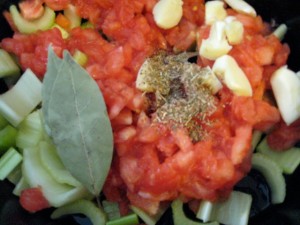
My other departure from the recipe was to dump a teaspoon of thyme and a couple of bay leaves into the slow-cooker with the vegetables, rather than making a “bouquet garni.”
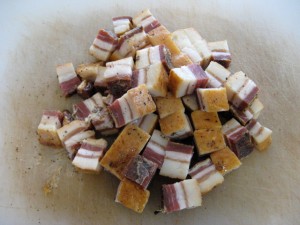
“250g salt pork, pancetta, or bacon, in chunky pieces.”
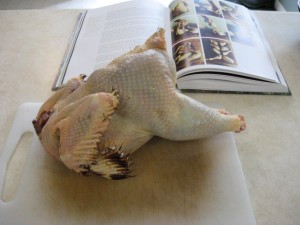
Now comes the difficult part – difficult, because I don’t have a whole lot of practice at it – jointing my chicken. In February of this year I spent an afternoon taking lessons on how to joint a chicken and chop vegetables efficiently from a local vegetable-grower who used to be a professional chef (he has flat feet and couldn’t deal with the 12-hour shifts in the kitchen, so he quit chefing and now grows vegetables for the local farmer’s market on his family farm instead…) It was time and money very well spent, and I mostly remembered what I was doing. The illustrations in Hugh’s book helped remind me of the finer points. The legs come off easily. The hardest part was splitting the breastbone with a heavy cleaver to separate the halves of the breast while leaving them on the bone.
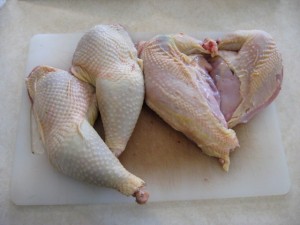
2 leg portions and 2 breast portions.

The neck and the back in a pot, ready to be boiled up for stock.

The leftovers, 2 wings and the tail. As is traditional, these pieces went to the dog and cats.

Because this is a Hugh recipe, you start by frying the chunks of bacon in 1 tablespoon of olive oil and approximately 3 tablespoons (50 grams) of butter. A couple of chopped onions get browned in the fat, and then in go the chicken portions for browning:

Hmmmm…. I think I need a larger frying pan.

Now for the FUN part! The recipe calls for 1/2 a wineglass full of brandy and 500 ml of red wine. The brandy is French. The red wine is my favourite VQA (local Ontario wine) from Pelee Island Winery.
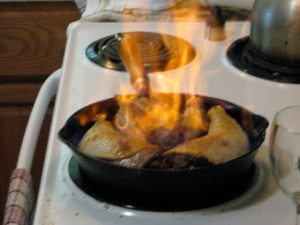
Speedy flambé.

Simmering in the slow-cooker. A couple of hours later I tasted the sauce. Delicious (and not at all too salty, which I was a little worried about, considering how salty the bacon tasted to me) but very, very fatty. I ladled off 500ml of sauce into a Pyrex measuring cup and put it in the fridge, so that I could separate out some of the fat. An hour before my guest arrived, I took the chicken pieces out of the slow-cooker, strained the liquid into a pot, and started reducing it. I took the reserved portion out of the fridge, skimmed off the excess fat (Gods!The fat!) and added it to the reducing pot. I probably should have boiled it down more than I did.
I returned the reduced liquid to the vegetables, bacon, and chicken pieces, and let it simmer gently in the slow-cooker until we were ready to eat. We had the chicken and sauce with kugelis (traditional Lithuanian potato pudding) which our guest brought, and a bottle of Château des Charmes (VQA) red wine.
It was absolutely delicious. The meat was perfectly tender, and tasted of chicken – despite having been simmered in red wine and bacon sauce for 5 hours! And it probably took less time to make the recipe than it did to write this post – the longest part was jointing the chicken. I will certainly make it again, served with boiled new potatoes if we don’t have a guest bringing Lithuanian kugelis.

